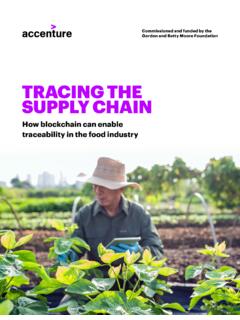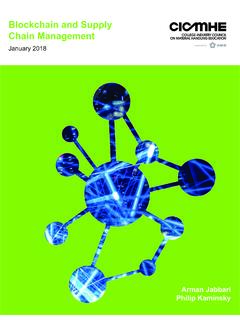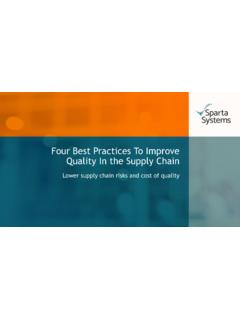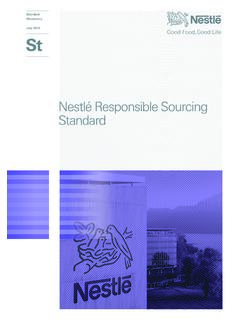Transcription of Good Single Points Manufacturing of Contact Practices
1 Good Single Points Manufacturing of Contact Practices Surveillance and Good Distribution Monitoring Practices 10 1. 9 2. Track and Good Import/. 8 3. Trace System Export Practices 7 4. 6 5. Internet Sales Clinical and Retail Pharmacy Practices Detection Product Technology Security Roadmap for supply chain Security Member economies of the Asia Pacific Economic Cooperation (APEC) and non-APEC economies alike are adversely impacted by the international movement of substandard and falsified (S&F) medical products. As the medical products industry has become more globalized and specialized, economies must increasingly rely on the global marketplace to provide the medical products needed to keep citizens healthy and ensure that access to legitimate products is not disrupted.
2 In an effort to address this modern issue, regulators, industry stakeholders, representatives from non-governmental organizations, international organizations, and academics from across the globe have come together as members of the Roadmap to Promote Global Medical Product Quality and supply chain Security ( Roadmap for supply chain Security ) project, a collaborative multi-year project commissioned by APEC with oversight by its Life Science and Innovation Forum (LSIF) and the Regulatory Harmonization Steering Committee (RHSC). This work culminated in the development of this supply chain Security Toolkit. The supply chain Security Toolkit is intended to cover the entire supply chain and life cycle of medical products ( raw materials to use by patients) and focuses on developing and implementing through training programs processes, procedures, and tools directed at enhancing global medical product quality and supply chain security.
3 The supply chain Security Toolkit contains recommended best Practices and tools to prevents and detect S&F medical products before they reach the consumer and to efficiently respond to incidents involving S&F medical products. Comprehensive product quality and supply chain security requires a multilayer approach that includes prevention, detection, and response strategies and actions. The supply chain Security Toolkit is a comprehensive resource that addresses areas of vulnerability in the medical product supply chain . It contains recommended best Practices and tools to prevent and detect S&F medical products before they reach the consumer and to efficiently and effectively respond to incidents involving S&F.
4 Medical products. This section highlights the utility of the toolkit in in the prevention, detection, and response of S&F medical products. In addition, the supply chain Security Toolkit can be used in conjunction with the World Health Organization's (WHO) guidance on developing a national plan for preventing, detecting, and responding to actions, activities, and behaviors that result in S&F medical products. This guidance is linked below. FINAL REPORT: APEC Roadmap to Promote Global Medical Product Quality and supply chain Security: supply chain Security Toolkit Prevention .Detection .Response World Health Organization: Guidance on Developing a National Plan for Preventing, Detecting, and Responding to Actions, Activities, and Behaviours that Result in Substandard and Falsified Medical Products PREVENTION.
5 Preventing Substandard, Spurious, Falsely Labeled, Falsified, Counterfeit (SSFFC) products from entering the supply chain requires, among other things: Improving transparency, accountability, and integrity of the supply chain by ensuring compliance with robust current good Manufacturing , distribution, and pharmacy Practices . Implementing track and trace systems and end-to-end product security and supply chain solutions to help ensure medical products are legitimate and enhance detection of illegitimate drugs. Ensuring robust import and export regulations to protect the legitimate medical product supply chain from entry of SSFFC products.
6 Strengthening oversight of the sale of medical products on the Internet, including who may sell and what may be sold, in order to prevent the entry of SSFFC medical products into the supply chain . DETECTION. Detecting Preventing Substandard, Spurious, Falsely Labeled, Falsified, Counterfeit (SSFFC) products in the supply chain requires, among other things: Incorporating detection technologies in order to improve surveillance and monitoring and identify products that are SSFFC. Improving surveillance, investigation, and actions against suspect SSFFC medical products. RESPONSE. Responding to incidents of Preventing Substandard, Spurious, Falsely Labeled, Falsified, Counterfeit (SSFFC) products in the supply chain requires, among other things: Establishing a Single point of Contact (SPOC) program among the national medical regulatory agency, law enforcement, and others in order to facilitate coordination, communication, and information-sharing regarding incidents with medical products.
7 Improving communication about incidents by reporting to the global surveillance and monitoring system for SSFFC medical products. Centers of Excellence The Roadmap to Promote Global Medical Product Quality and supply chain Security was developed under the auspices of the APEC Regulatory Harmonization Steering Committee (RHSC). The RHSC established the Centers of Excellence (CoEs) model to link APEC/RHSC harmonization initiatives with training institutions and key players in the healthcare field, to maximize the use of public and private partnerships and other available resources. The CoE's role is to develop content and deliver quality trainings based on the toolkit materials developed by the members of the Roadmap to Promote Global Medical Product Quality and supply chain Security.
8 To date, RHSC has endorsed two CoEs to conduct pilot programs on medical product supply chain security: 1. United States Pharmacopeial Convention (USP). USP's pilot program focuses on enhancing the implementation and sustainability of the RHSC's supply chain Integrity Roadmap best Practices , covering compendial standards, good Manufacturing Practices , good distribution Practices , screening technologies, and internet sales. 2. University of Tennessee Health Sciences Center (UTHSC). UTHSC's pilot program focuses on protecting patient safety in the global marketplace through good distribution Practices and product security measures.
9 Good Manufacturing Practices (GMP). Appropriate Manufacturing is essential for global medical product quality and supply chain security. The materials below identify best Practices related to medical product supply chain security, providing current good Manufacturing Practices (CGMP) recommendations for stakeholders. These recommendations for best Practices are intended to minimize divergent Practices and opportunities for the introduction of substandard, spurious, falsely-labeled, falsified, or counterfeit medical products into the global supply chain . The information and materials below are intended for industry stakeholders and National Medical Regulatory Authorities (NMRAs)- 1.
10 Industry may use this information to adopt best Practices ;. 2. NMRAs may use this information to strengthen laws and regulations; and 3. Industry and government may use for training purposes. GMP Tools Introduction Good Regulator Practices supply chain Verification Outsourcing Show and Shadow Factories Incoming Material Checking Yield and Reconciliation Repackaging Product Release Procedure Rejected and Returned Material GMP GAP Assessment Good Distribution Practices (GDP). To ensure supply chain security and integrity and maintain product quality, good distribution Practices (GDPs) should be followed by all stakeholders as medical products move through the supply chain .







